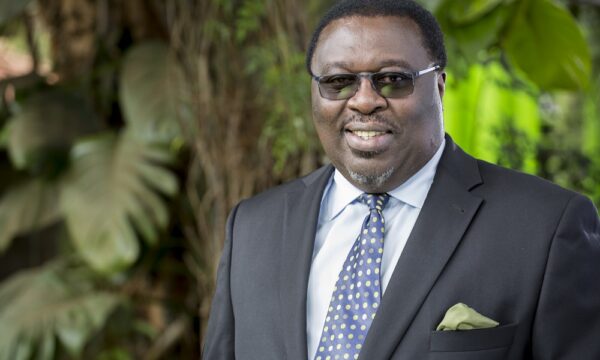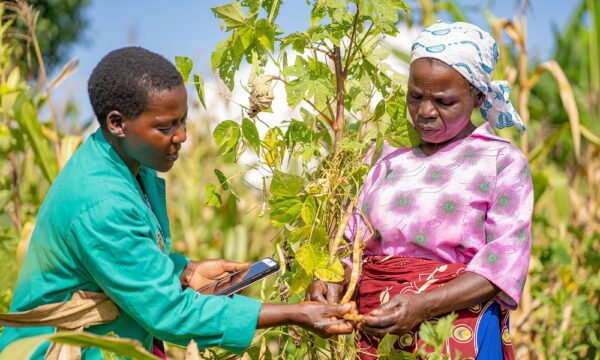
CABI scientist Dr Iva Franić has successfully defended her PhD thesis looking at the risks of pest and disease movement via plant and seed exchanges.
Dr Franić, co-supervised by Dr René Eschen, Research Scientist, Ecosystems Management, and Risk Analysis and Invasion Ecology at CABI, obtained her PhD degree from the University of Bern in Switzerland, for her thesis entitled ‘The diversity of insects and fungi associated with trees: A plant health perspective.’
Given the current restrictions in response to the COVID-19 outbreak, Dr Franić’s defense was held via Zoom with two members of the exam committee and a few spectators in a conference room at CABI’s Swiss Centre in Delémont.
The other four members of the exam committee joined from their respective homes and another 40 people, including her family and friends, watched the proceedings from various locations in the CABI building or elsewhere in Europe.
Dr Eschen said, “Iva has done an impressive amount of work, in collaboration with the Swiss Federal Institute for Forest, Snow and Landscape Research WSL and many scientists from across Europe and the rest of the world, which was summarised in a recent article in the BGJournal.”
Dr Franić’s research, which was led by CABI and the Federal Institute for Forest, Snow and Landscape Research (WSL) in Switzerland and funded by the Swiss National Science Foundation and related to COST Action Global Warning, assessed phytophagous insects and fungi in tree seeds purchased from commercial suppliers and fungi in tree seeds collected in botanic gardens in Europe and the USA. The team also considered fungi and insects in dormant twigs from 32 countries to assess the diversity of such organisms and factors that may facilitate their establishment in other countries.
The results of the assessment of risks associated with seed trade have been published in Ecological Applications, and the manuscript describing the relative importance of host and environment related factors on fungal communities associated with seeds in botanical gardens is currently under review. A manuscript about the large-scale diversity of insects and fungi associated with dormant tree twigs is currently under preparation and will be submitted during this year.
In the first paper, entitled ‘Risks of Pest and Disease Movement via Plant and Seed Exchanges,’ Dr Franić et al argue that traded tree seeds pose a greater risk of pest introduction than previously thought, but only a few species represent a real phytosanitary risk because these can be transferred from the seed to the seedling. More research is needed to gather data for better risk assessments, she and the other scientists suggest.

In addition to the chapters presented in this thesis, Iva provided contributions to two published papers, in particular for a paper on factors determining global patterns in associate biodiversity, where she was one of the driving forces and did most of the data analysis as well as an important part of the conceptualisation. She also presented and defended the results of her first study at a meeting of the International Forest Quarantine Research Group, under the International Plant Protection Convention in Rome.
Among the recommendations stemming from Dr Franić’s research these include surface sterilisation of seeds prior to sowing to remove fungi on the seed coat and growing seeds in greenhouses before planting them in the garden to allow closer surveillance to detect pathogens earlier.
Additional information
Main image: Dr Iva Franić delivers her PhD defence remotely using video conferencing due to the coronavirus restrictions of social contact.
Dr Franić’s papers
Iva Franić, Eric Allan, Simone Prospero and René Eschen, ‘Risks of Pest and Disease Movement via Plant and Seed Exchanges’, BGCI, 2020, BGJournal, Vol 17 (1).
This paper can be viewed here on SCRIBD: https://www.scribd.com/document/453340902/Franic-Et-Al-2020-BGjournal17-1HR
Iva Franić, Simone Prospero, Martin Hartmann, Eric Allan, Marie-Anne Auger-Rozenberg, Niklaus J. Grünwald, Marc Kenis, Alain Roques, Salome Schneider, Richard Sniezko, Wyatt Williams, René Eschen, ‘Are traded forest tree seeds a potential source of non-native pests?’, Ecological Applications, 2019, DOI: 10.1002/eap.1971
This paper is available here: https://esajournals.onlinelibrary.wiley.com/doi/full/10.1002/eap.1971
Eschen R, De Groot M, Glavendekić M, Lacković N, Matošević D, Morales-Rodriguez C, O Hanlon R, Oskay F, Papazova I, Prospero S, Franić I (2019) ‘Spotting the pests of tomorrow—Sampling designs for detection of species associations with woody plants’, Journal of Biogeography.
This paper is available here:
https://onlinelibrary.wiley.com/doi/full/10.1111/jbi.13670
Morales-Rodríguez C, Anslan S, Auger-Rozenberg M-A, Augustin S, Baranchikov Y, Bellahirech A, Burokienė D, Čepukoit D, Çota E, Davydenko K, Doğmuş Lehtijärvi HT, Drenkhan R, Drenkhan T, Eschen R, Franić I, Glavendekić M, de Groot M, Kacprzyk M, Kenis M, Kirichenko N, Matsiakh I, Musolin DL, Nowakowska JA, O’Hanlon R, Prospero S, Roques A, Santini A, Talgø V, Tedersoo L, Uimari A, Vannini A, Witzell J, Woodward S, Zambounis A, Cleary M (2019) ‘Forewarned is forearmed: harmonized approaches for early detection of potentially invasive pests and pathogens in sentinel plantings’, NeoBiota 47: 95–123.
This paper is available here:
https://neobiota.pensoft.net/article/34276/
Related News & Blogs
Biosecurity and skills development workshop brings together key players in Africa’s plant health ecosystem
CABI has convened a plant biosecurity training and skills development workshop bringing together key players in Africa’s plant health ecosystem keen to help the continent’s smallholder farmers improve their livelihoods and food security. The workshop w…
23 June 2025




